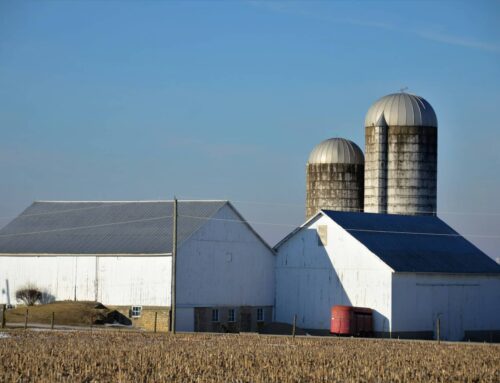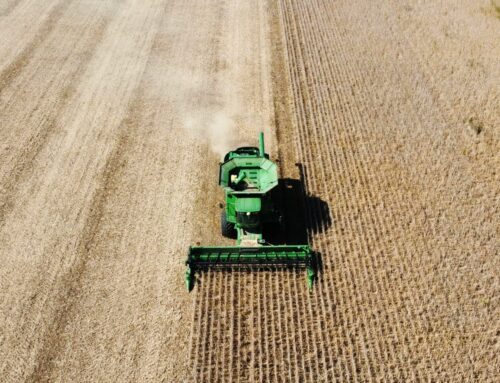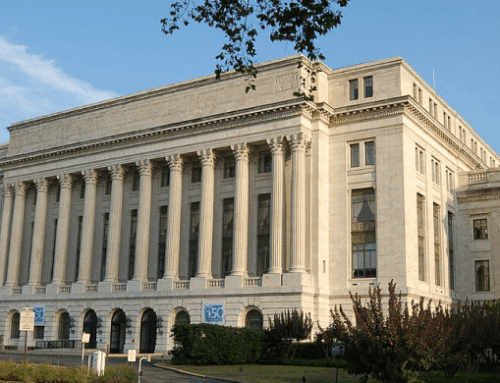Payouts for Private Developers of Publically Subsidized Crop Insurance
NOTE: Red bold indicates text that will be added by the House Agriculture Committee farm bill. Strikethrough indicates text stricken from the bill.
Tucked into page 579 of the farm bill passed by the House Agriculture Committee is a little-noticed section that will cost taxpayers millions. “Sec. 10007 Maintenance of Policies” includes language to force taxpayers to reimburse private companies for millions of dollars in costs the companies claim when developing and maintaining new subsidized crop insurance policies for the program—even when the Risk Management Agency that oversees crop insurance finds these claimed costs to be unreasonable.
The farm bill takes discretion away from RMA and spells out exactly what the crop insurance corporation board can find as “reasonable” costs in developing and maintaining new policies. But even here there is an escalation clause in that the bill adds the language “and actual” after “reasonable.” So taxpayers have to pay for inflated, farm bill-defined “reasonable” costs “and actual” costs even if those are by the farm bill’s very own definition, unreasonable!
This is just yet another example of how the farm bill is less a vehicle for creating a cost-effective safety net for all of agriculture and more a package of parochial payouts for the Ag committee’s pals.
Background
In the federally subsidized crop insurance program new crop insurance policies can be developed either when the farm bill sets “research and development” priorities for RMA, or when organizations or institutions outside of RMA submit concept proposals. This latter process, known as 508(h), has resulted in dozens of new policies over the years. It’s also sprung forth a cottage industry of players who make a lucrative return on their development of policies. That’s because companies can be reimbursed for their “reasonable” research and development costs as well as the costs of maintaining these policies for the first four years they are being sold.
RMA has been trying to get a handle on these costs. The House Farm Bill will thwart this attempt at fiscal responsibility.
Timeline of a Cronyistic Carveout
- September 2016 – Crop insurance board tells for-profit private submitters seeking reimbursement “…the Board will be revising its procedures to require more meaningful information that will allow it to better assess the work required and whether the hours, wage, and rates claimed to accomplish that work are reasonable.”
The Board then makes reimbursements under the non-reformed rules
| September 21, 2016 FCIC Board Meeting | ||
| Amount | Type of Reimbursement | Crop insurance policy |
| $23,739.51 | first-year maintenance expenses | ARPI Popcorn |
| $15,804.40 | remaining-fourth-year maintenance expenses | Specialty Trait Soybeans |
| $37,878.45 | fourth-year maintenance expenses | Specialty Corn |
| $45,570.31 | fourth-year maintenance expenses | Specialty Canola |
| $227,613.25 | first-year maintenance expenses | Malt Barley |
| $192,687.16 | fourth-year maintenance expenses | Pulse Crop Revenue |
| $10,041.55 | remaining-fourth-year maintenance expenses | Popcorn Revenue |
| $625,446.95 | first-year maintenance expenses | Margin Protection (Watts) |
| $71,002.90 | first-year maintenance expenses | Margin Protection (FarmRisk) |
| $88,060.29 | third-year maintenance expenses | Machine Harvested Cucumber |
| $15,802.12 | first-year maintenance expenses | Clary Sage |
| $10,219.73 | remaining-fourth-year maintenance expenses | Louisiana Sweet Potatoes |
| $298.13 | fourth-year maintenance expenses | Camelina |
| $322,013.52 | research and development expenses | Sugarcane Improvements |
| $103,261.30 | second-year maintenance expenses | Peanut Revenue |
| $147,998.84 | third-year maintenance expenses | Downed Rice |
| $92,741.75 | remaining fourth-year maintenance expenses |
Trend APH |
| $80,505.64 | research and development expenses | Hybrid Rice Seed |
| $212,372.68 | fourth-year maintenance expenses | Annual Forage Rainfall Index |
- November 2016 – the board releases these new standards and they take effect. Also gives companies 60 days to make comments.
- February 2017 – the board defends its actions against fierce backlash from the for-profit private developers—“The Board’s concerns were not with the statutory or regulatory requirements, but rather with the form and detail of the data provided pursuant to the Board’s procedures.
Based on discussions with private submitters at the September 2016 Board meeting, we believed that the type of changes sought in the November procedures were mostly clarifying in nature and consistent with the manner in which many of those submitters already keep track of their expenses…”
- May 2017 – the board approves new procedures for determining reasonableness of reimbursement requests.
- September 2017 – the board makes a number of reimbursements based on these new standards
| September 27, 2017 FCIC Board Meeting | ||
| Amount | Type of Reimbursement | Crop insurance policy |
| $815,095.00 | second-year maintenance expenses | Margin Protection |
| $232,625.00 | second-year maintenance expenses | Malt Barley Revenue |
| $23,358.00 | second-year maintenance expenses | ARPI Popcorn |
| $1,152,322.00 | research and development expenses | Pecan Tree |
| $484,648.00 | research and development expenses | Triticale |
| $55,509.00 | fourth-year maintenance expenses | Downed Rice Endorsement |
| $156,211.00 | third-year maintenance expenses | Peanut Revenue |
| $3,735.00 | first-year maintenance expenses | Hybrid Rice Seed |
| $40,036.00 | first-year maintenance expenses | High Amylose Corn |
| $247,427.00 | first-year maintenance expenses | Sugarcane |
| $20,304.00 | second-year maintenance expenses | Clary Sage |
| $98,445.00 | fourth-year maintenance expenses | Machine-Harvested Cucumbers |
April 2018 – House Agriculture Committee farm bill plants unreasonable payments
The House Agriculture Committee passed farm bill makes a number of changes that will reverse RMA’s new procedures for confirming taxpayers are not being fleeced by these crop insurance policy developers.
It does this by requiring higher reimbursements for research and development costs.
It also allows companies to determine the costs for maintaining these policies.
And it makes all these changes retroactive to 2016.
Sec. 10007 Maintenance of Policies
(1) Research and development payment
(A) In general
The Corporation shall provide a payment to an applicant for research and development costs in accordance with this subsection.
(B) Reimbursement
(i) In General – An applicant who submits a policy under section 1508(h) of this title shall be eligible for the reimbursement of reasonable and actual research and development costs directly related to the policy if the policy is approved by the Board for sale to producers.
(ii) REASONABLE COSTS.—For the purpose of reimbursing research and development and maintenance costs under this section, costs of the applicant shall be considered reasonable and actual costs if the costs are based on—
(I) wage rates equal to 2 times the hourly wage rate plus benefits, as provided by the Bureau of Labor Statistics for the year in which such costs are incurred, calculated using the formula applied to an applicant by the Corporation in reviewing proposed project budgets under this section on October 1, 2016; or
(II) actual documented costs incurred by the applicant.
In addition to reimbursing research and development costs, RMA can pay maintenance fees (for four years) on any newly developed policy. Basically to ensure the kinks are worked out and the policy is viable. The insurance companies that maintain and sell these policies can be reimbursed a fee for this maintenance.
The House bill allows non-insurance companies to develop and maintain policies and it allows them, not RMA, to determine the cost of maintenance.
Under 7 U.S. Code § 1522(b)(4) Maintenance Payments
(D) Fee
(i) Amount
Subject to approval by the Board, the amount of the fee that is payable by an approved insurance provider applicant that elects to sell the policy shall be an amount that is determined by the approved insurance provider applicant maintaining the policy.
(ii)Approval The Board shall approve the amount of a fee determined clause
(i) for maintenance of the policy unless the Board determines that the amount of the fee—
(I)is unreasonable in relation to the maintenance costs associated with the policy; or
(II) unnecessarily inhibits the use of the policy.
‘‘(ii) APPROVAL.—Subject to clause (iii), the Board shall approve the amount of a fee determined under clause (i) unless the Board determines, based on substantial evidence in the record, that the amount of the fee unnecessarily inhibits the use of the policy.
‘‘(iii) CONSIDERATION.—The Board shall not disapprove a fee on the basis of—
(I) a comparison to maintenance fees paid with respect to the
policy; or
(II) the potential for the fee to result in a financial gain or loss to the applicant based on the number of policies sold.
**So the Board can reject the proposed maintenance fee if the Board determines it will be so high as to discourage farmers from buying the policy. The board CANNOT reject a maintenance fee if the Board determines that the company’s claimed costs for maintenance are unreasonable.
This is made retroactive to October 1, 2016. And anybody previously denied all or a portion of reimbursement requests can resubmit their reimbursement request.
Conclusion
Taxpayers can afford to create a cost-effective, transparent safety net for businesses involved in agriculture. Taxpayers cannot afford a farm bill packed with parochial payouts for special interests.










